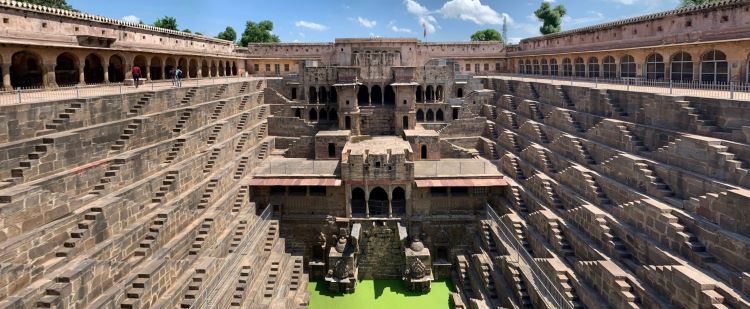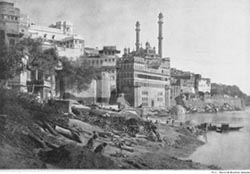Leisure: Sightseeing
 |
|
Diary (1902-1904): 6th May 1904 (p.198-199) [LDGSL/348/2/3]. Click to enlarge. |
Besides hunting, Fermor did also take the opportunity to do some sightseeing, usually at the beginning and end of the field seasons when he was staying in towns or cities. Often this took the form of visits to temples and forts, but while staying in Nagpur in October 1903 he visited the Empress Cotton Mills. This was the country’s first textile mill, and was also the first big industrial project taken on by Tata – a name you may recognise as that of an Indian multinational company still thriving in many sectors today, including, coincidentally, Indian manganese ore mining! Fermor toured the ‘very large’ mills, describing in his diary the whole process of producing cotton cloth.
 |
|
Chand Baori, in Abhaneri, Rajasthan, one of the most famous baoris or baolis (stepwells), 2012. [By Chetan (Own work) [CC-BY-SA-3.0 (http://creativecommons.org/licenses/by-sa/3.0)], via Wikimedia Commons.]
|
Many of the places that Fermor mentions as sites of interest, though not necessarily places he specifically visited for sight-seeing purposes, involve water. This may be connected to the fact that water has a special significance in Hinduism; it is used particularly for purification, and bathing in a holy river is especially meaningful. During his first field work season Fermor frequently spent time around one of these, the Nerbudda (Narmada), and the next year visited Benares (Varanasi), through which the most holy river, the Ganges, flows. On these rivers and others he noted many ghats – steps leading down to the river where Indians could bathe, wash their clothes, and, at special cremation ghats, burn the bodies of the dead. He also makes references to baoris or baolis, such as the ‘rather good baolis’ at Gosalpur and Jujhari on the road to Jabalpur. These are stepwells, traditional, usually square or rectangular, structures built into the ground to retrieve groundwater with steps around the side providing access down to water level.
 |
| Benares (Varanasi), 1899. [By Bourne & Shepherd, Calcutta [Public domain], via Wikimedia Commons.] |
Benares (Varanasi) was Fermor’s final destination before returning to Calcutta (Kolkata) in May 1904. As stated above, this ancient city is situated on the banks of the Ganges, with the diary recording two sight-seeing boat trips and mentioning numerous ghats including Dasasamedh (Dashashwamedh), Raj, Manikaranika (Manikarnika), Durga, and Panchganga (Pancaganga). Manikaranika (Manikarnika) ghat is a particularly sacred cremation ghat. Fermor referred to such places as ‘burning’ ghats, and describes one as follows:
There were 3 bodies being burnt here, 2 of which were practically finished. A fourth body clothed in golden cloth, with the head and face also completely covered was lying ready.
6th May 1904
During his two and a half days in Benares (Varanasi) Fermor visited a quite remarkable number of sites – temples, palaces, mosques, and forts – and even found time to fit in shopping, buying some enamelled brassware and a tablecloth. His views on the places he visited varied, from Jai Singh’s observatory, which he found ‘exceeding interesting’, and Aurangjeb’s Masjid (mosque), from the top of which ‘the view is magnificent’, to Durga Temple, where the famed monkeys ‘were not in great numbers’, and Bisheshwan (Kashi Vishwanath)/the Golden Temple, which he thought ‘very disappointing [...] All the domes are not now gilded’ (5th-6th May 1904).